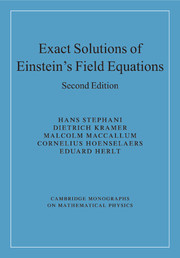The possible space-times with isometries
In specifying the symmetry properties of a metric one has to state the dimension of the maximal group of motions or homotheties, its algebraic structure, and the nature and dimension of its orbits. For this purpose we shall, as in §8.4, use the following notation: the symbols S, T and N will denote, respectively, spacelike, timelike and null orbits, and will be followed by a subscript giving the dimension. If an isometry group is transitive on the whole manifold V4, the space-time will be said to be homogeneous. If an isometry group is transitive on S3, T3 or N3, the spacetime will be called hypersurface-homogeneous (or, respectively, spatiallyhomogeneous, time-homogeneous, or null-homogeneous).
Petrov (1966) and his colleagues were the first to give a systematic treatment of metrics with isometries, and we therefore inevitably recover many of Petrov's results in the following chapters.
It turns out that if the orbits are null, the construction of the metric and the understanding of its properties have to be achieved by a rather different method from that used when the orbits are non-null. Accordingly we give first the discussion of non-null orbits (Chapters 12–22) and later the discussion of null orbits (Chapter 24). Within this broad division we proceed in order of decreasing dimension of the orbits.
